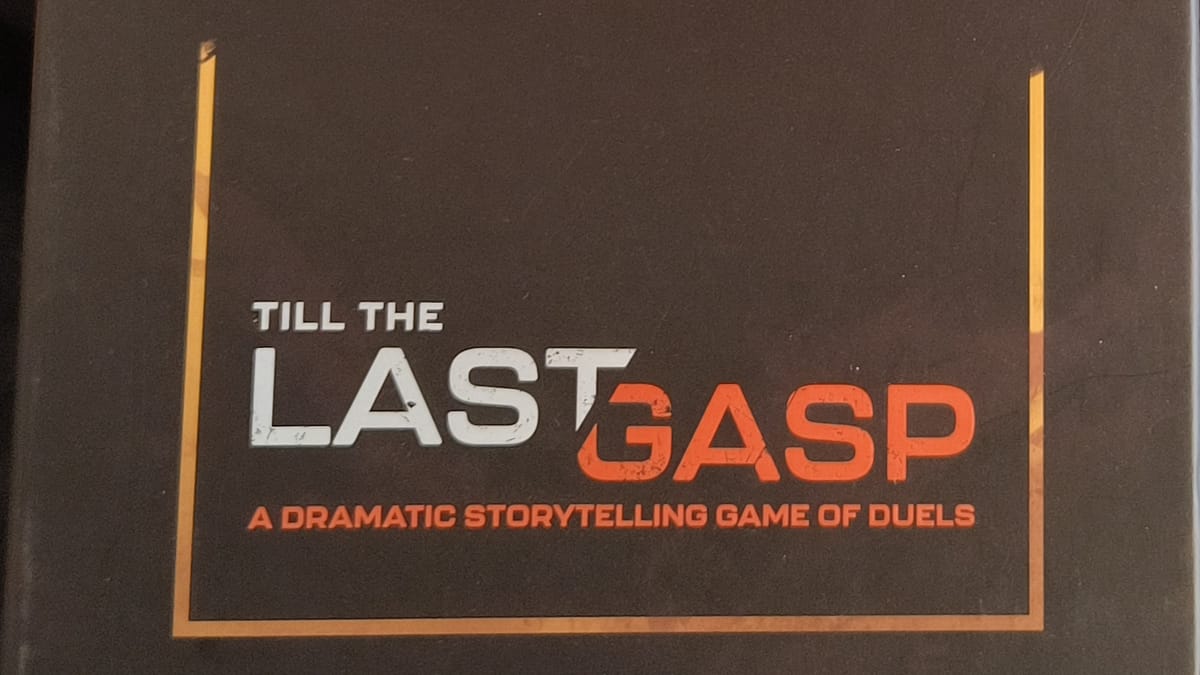
The duel: two combatants enter, one combatant leaves. That is the basic premise of Till the Last Gasp, a two player collaborative storytelling board game from publisher Derrington Press.
To start, each player will either choose a character from the provided set of characters, or choose to make their own. Then the two players will decide on which arena to fight in. There are several different thematic arenas, from an Aztec themed wrestling arena to a flying pirate ship, a magi-tech castle to a space port on the moon. Then each player will choose an objective card from the three given to them, and then choose a stance to start with. Finally, they take five of the six sided dice of their color, and put them on either side of initiative die on the board.
From there, players will introduce their characters, how they enter, what they want, and why the opponent stands in their way. Then, they each will roll a d20 and a number of d6 from the top of their board in the areas matching their stance. This will determine how many actions each player can take in a single round, and the highest number of the d20 determines who goes first in the round.
Players take turns using their action points to take actions chosen from a list on their stance card and the location the fight is in right now. These actions will allow players to break scenery, wound the other fighter, move the fight around, force a player into a new stance, or possibly force the opponent to draw a drama card, which is an opportunity for roleplay.
The game ends when one player completes three of the four objectives on their objective card, and then has four action points to “end the duel decisively”. This doesn’t necessarily mean winning the duel, but instead choosing the result. It could even mean the player taking the action surrenders, or runs away. The duel ends, one way or another.
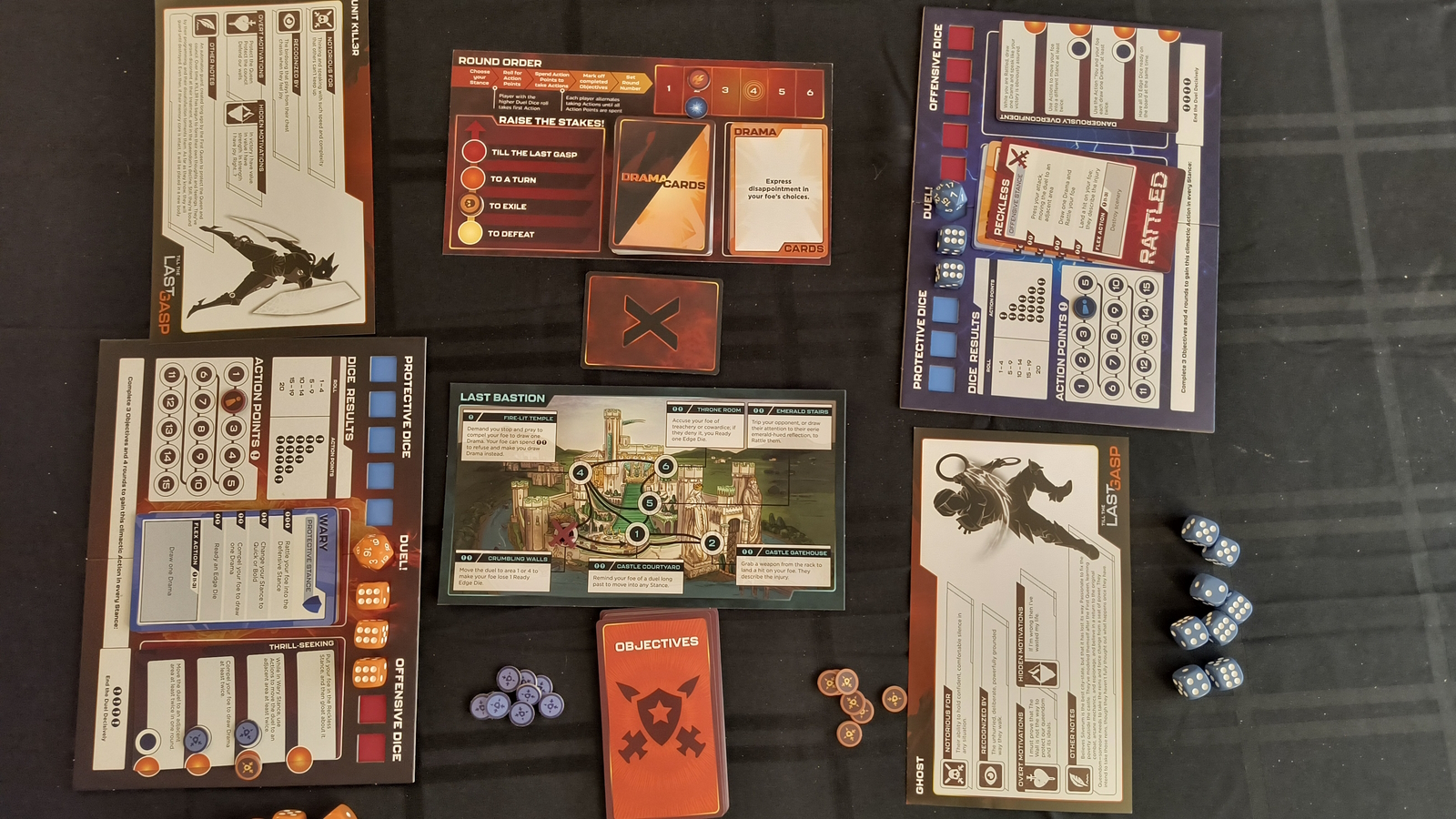
Now, you may notice I used the words “wound the other fighter”, but the game doesn’t have any method at all to track wounds given during the game. The player taking the wound simply describes it, and it is on the players to keep it in mind going forward. Similarly, no mechanic exists around breaking scenery either. Players are expected to use these things narratively, but it’s here that things start to fall apart. Because there is no mechanical weight to the fight, both players have to go into this game with a strict understanding that things might not go their way, and without a mechanic underpinning the direction of combat the reason things don’t go their way will be strictly the other player’s fault. If neither player is willing to “give ground”, then the game cannot come to a satisfying conclusion in any way. That means this game is basically unplayable with a wide array of people, and is something I will never be able to approach strangers with.
There is a deck of cards designed to help players bring interesting narrative elements into the game, but they just feel like they get in the way. The Drama cards, which players are forced by the other player using an action to draw, don’t really feel narratively cohesive. On paper, some work, like “Compliment your opponent”, but not all of them work for the narrative beat it has been drawn for. I think the Drama cards would have worked better as objectives to work towards, building up to situations where the action on the card actually made sense, and providing a reward when that happened.
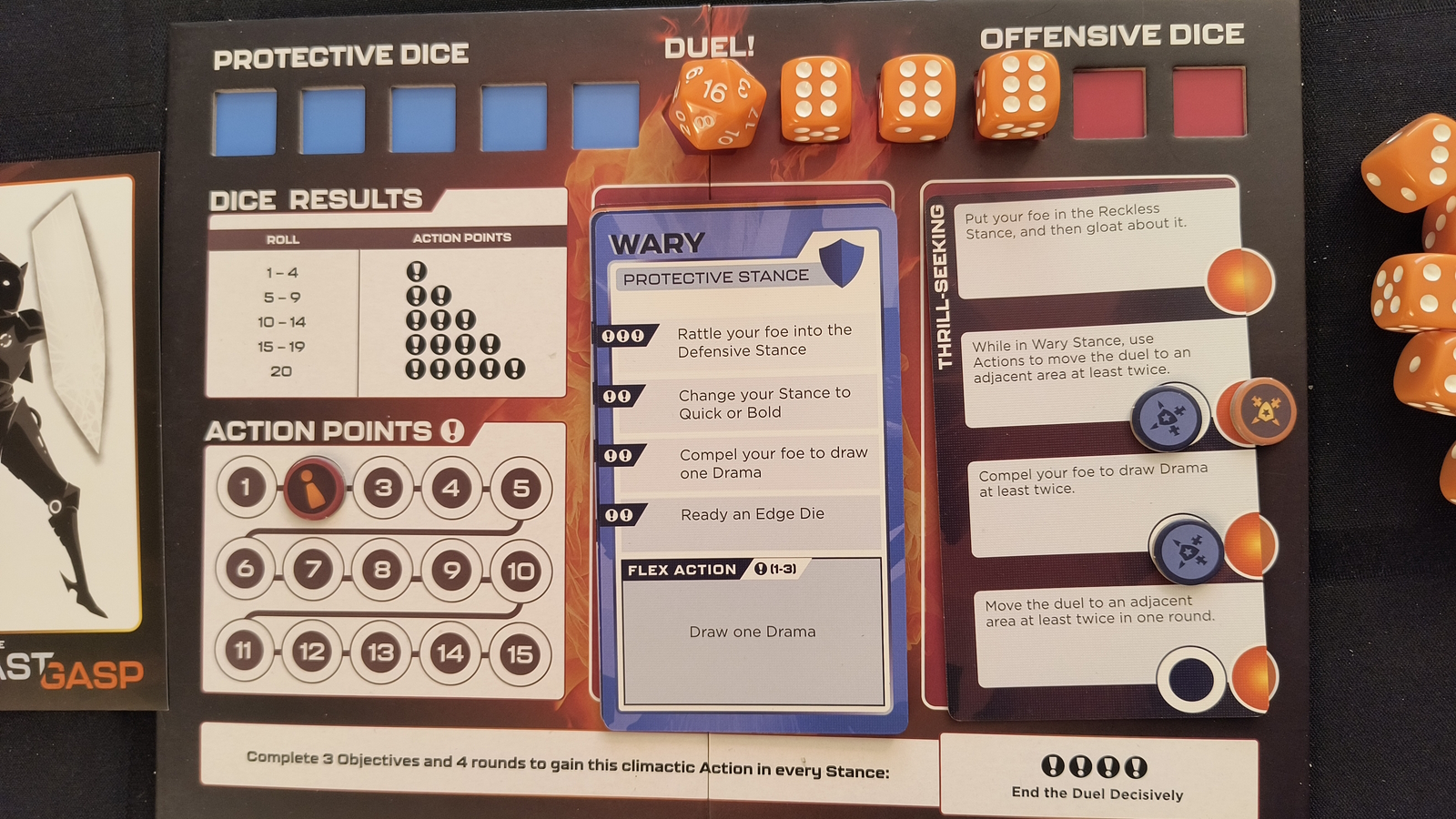
The other thing that really gets me about drama cards is that they are all verbal. A fight is a conversation with weapons. The verbal jabs and such are the punctuation to what’s really being said. The drama cards should have had something like “flourish your weapon unnecessarily” or even new details added to the story like, “your opponent broke something dear to you, what was it?”. The fact that it’s all conversational quips makes me think of this as less of a duel and more like marriage counseling between two killers.
Similarly, the objectives that the game does have are nothing more than checklists of things to interact with in the game. Things like “destroy scenery three times” or “force an opponent to draw a drama card three times”. They don’t have any narrative weight, which is a weird thing for a game that tries to tie everything to the narrative the players are creating.
Till the Last Gasp takes its name from the stakes track on the communal game board. The Stakes of the duel are either to defeat, to exile, to a turn (forcing them to join their opposition) or till the last gasp (to death). But, much like everything else in this game, there are no narrative stakes to this. Players must agree to the stakes at the beginning, and if they want to raise them, both must also agree. I feel like each player having their own stakes in the fight would have felt better, so you can have mismatches of one fighter aiming to kill, while another aiming to just get them to stop their rampage. Very seldom in fiction are fights about an agreed upon stakes. It also undercuts any narrative tension by allowing players to lower the stakes at the behest of a single player at any time. I get that if you have a character you are attached to, you don’t want them to get killed, but I can’t help feeling like that’s something you’d want to think about before agreeing to a duel to the death. I get the idea of wanting to make a safe space for roleplay, but this feels very lame. I suppose if there were actually mechanics to combat instead of a scavenger hunt, this could have operated differently as well.
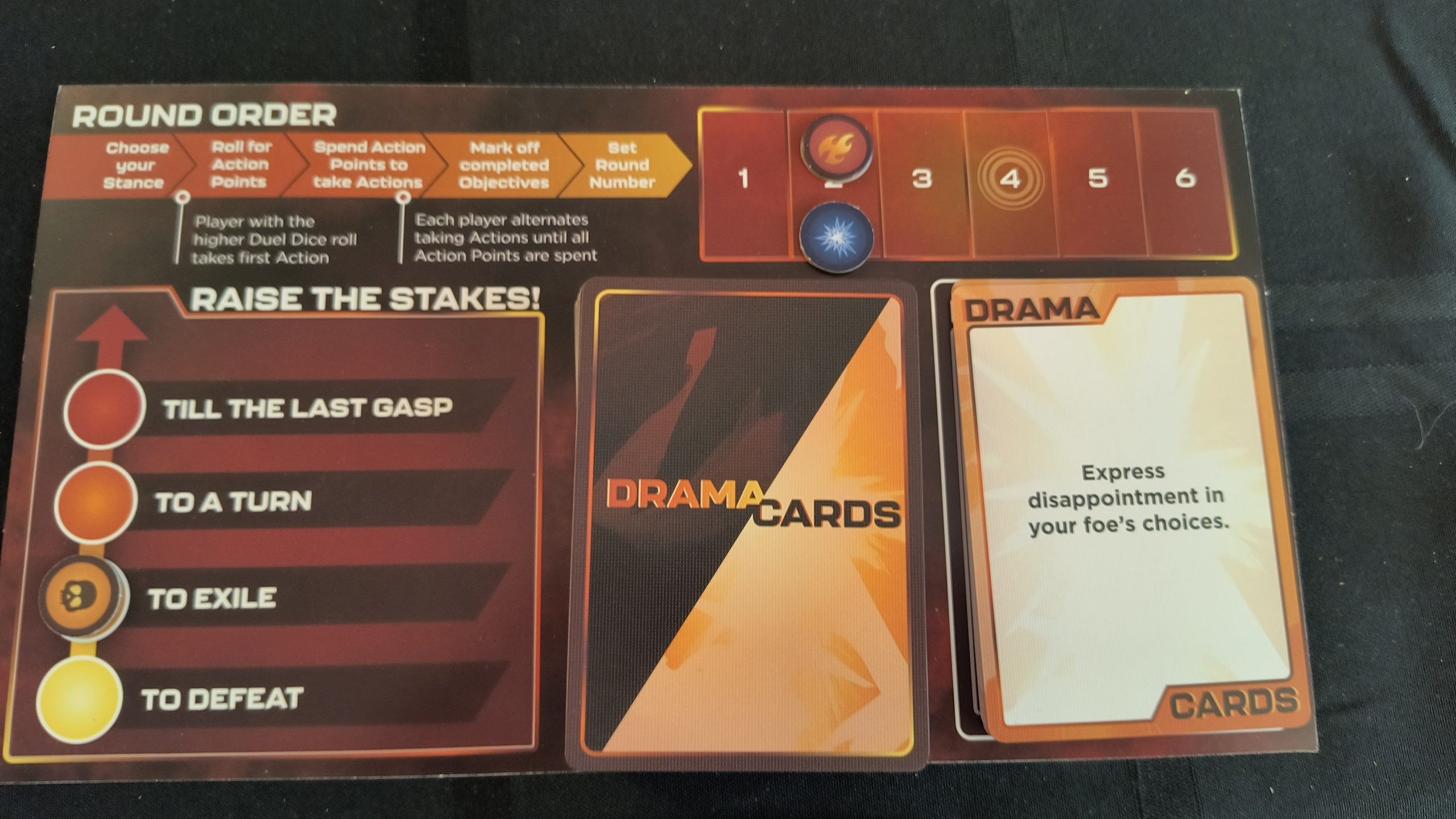
The game also has 20 d6, a criminal number of dice to use in such a pitiful way. This is because the action point economy of the game is disappointing. At the start of each round, players will choose how many of their readied d6 Edge dice to roll alongside their d20 initiative die. Then, each die is compared separately to a chart. The d20 can give anywhere from 1 to 5 action points, while the d6 gives a measly 1-2 action points. Actions can be used to ready more edge dice, but they don’t come back otherwise.
It feels weird to me that action points are the only thing the dice are for. In most roleplaying games, the action economy is the most important thing to keep balanced, so one player doesn’t hog the scene, and the kinds of actions you choose is where the interesting stuff happens. In Till the Last Breath, action points are the only mechanical way a player has to show their character in a dominant position. Even the game seems to notice this weird imbalance in action economy, asking nicely in the rulebook for characters that have more actions than the other player to blow them on the flex actions, like breaking scenery or drawing 3 drama cards (oh boy!).
The stances are the closest this game has to actual mechanics, but all they do is limit what your character can do in a single round. Tired of the scenery? Too bad, you’re not in a stance that’s allowed to move the fight somewhere else. Want to spend a random action to ready an edge die because you’re at a loss of what else to do? Can’t do that, you’re not in a defensive stance. If the limitations felt attached to the stance you were in, there could be interesting intersections of mechanics and narrative where players could force an opponent out of a stance where they were dominant, but the things one stance can do that another cannot feel arbitrary.
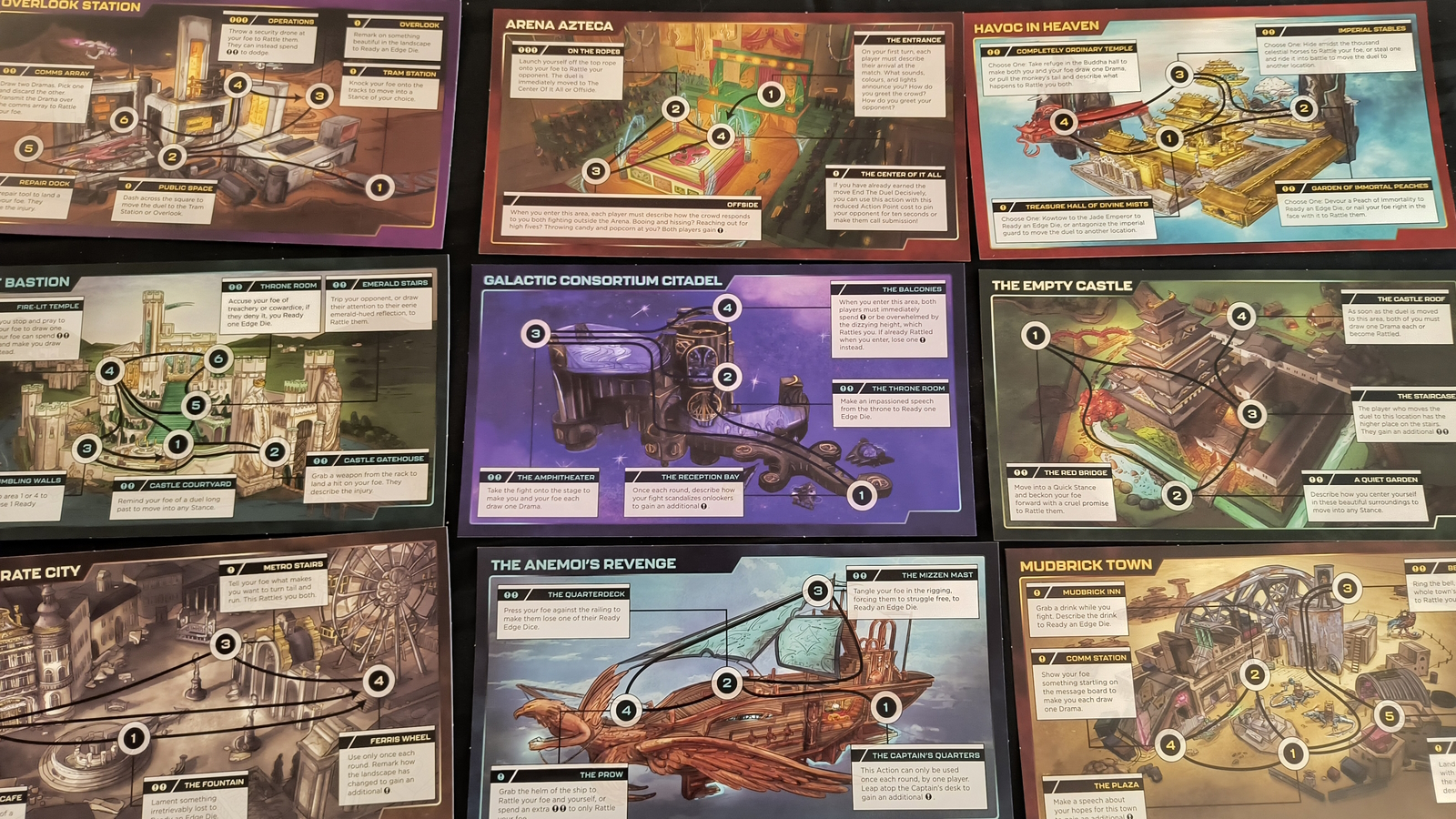
I do want to at least mention the design and quality of Till the Last Gasp. The birds-eye-view art on each of the arena cards is beautiful, and the striking silhouettes used on each of the pregenerated characters offers just enough visual information to know what they’re about while letting players fill in the gaps. Everything is printed on high quality stock, and even the dice are pleasingly neon-orange and shock-blue. Even then, there are weird choices made with those components. The round marker is two separate tokens, which are only ever moved as a pair. The game comes with objective markers, but while every other component comes in orange and blue for the orange and blue player, these are expected to be mixed and matched, with blue marking partial objective completion, and orange marking full completion.
Honestly, I think Till the Last Gasp fundamentally misunderstands why people enjoy roleplaying games. Roleplaying game systems give a framework for storytelling that removes blame and guilt from the equation. If a player dies in Dungeons and Dragons, the DM can shrug and say “the dice rolled that way”. It also gives players a wall they can hide behind when they are doing something that would otherwise embarrass them. Steve the desk jockey might not say “I will stop you, villain!” in a heroic voice, but Kairn the dragonborn paladin certainly would. When you take out the mechanics, the numbers on the sheet, you take out what ordinary people use to hide behind their character. A skilled actor might not need those things to inhabit their character, but roleplaying is for everyone, not just skilled actors.
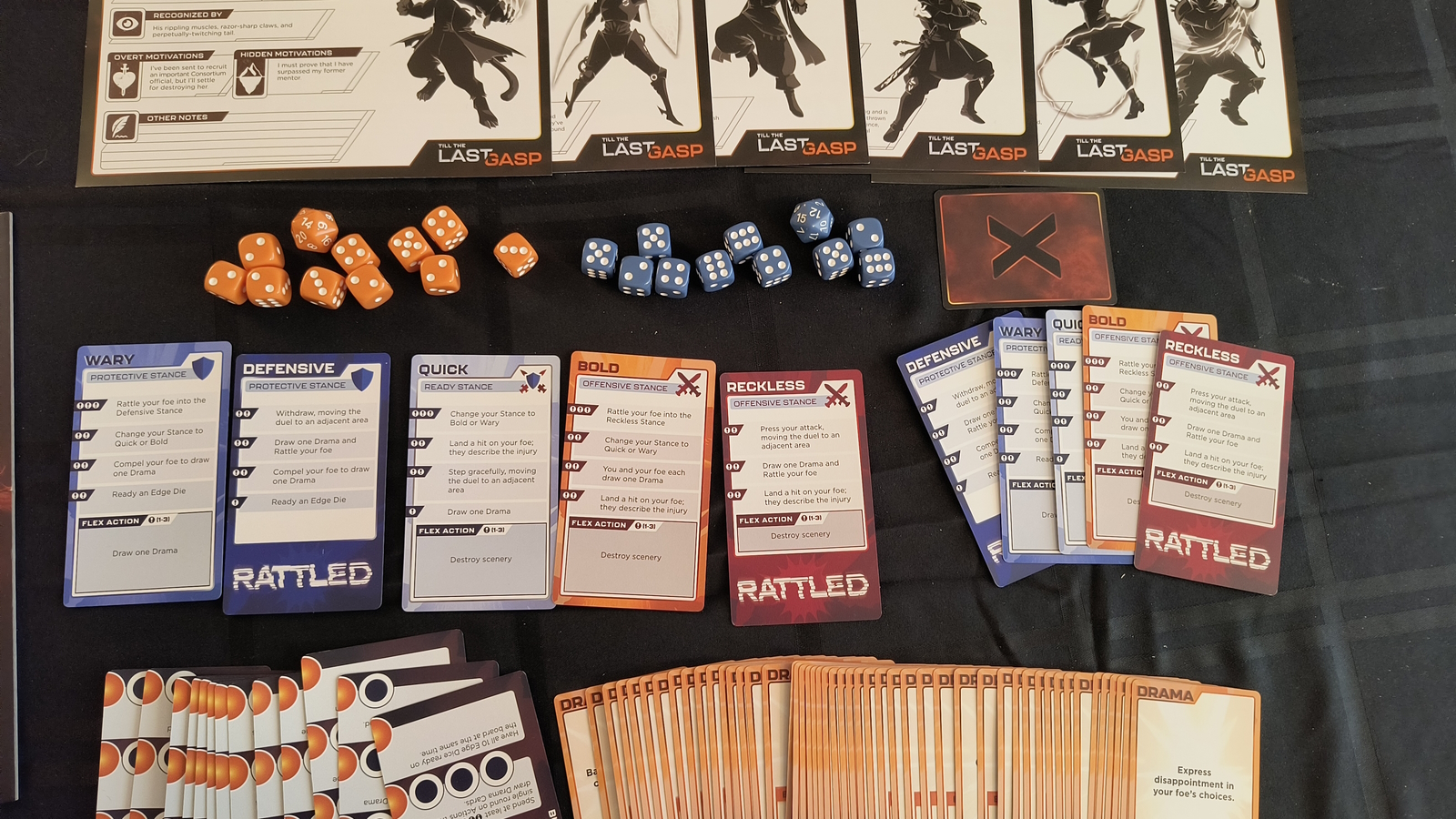
The character creation system that Till the Last Breath lays out asks 5 basic questions: What is the character’s name, what are they notorious for, what makes them stand out, what are their overt motivations, and what are their hidden motivations. This might be enough for a basic understanding of the narrative function of the duel, but does it tell you how that character fights? Each pair of these built-in characters also come with scenarios that have some intriguing worlds to fight in, but never provide the amount of backstory Till the Last Gasp seems to demand.
Narrative combat can work, but without a mechanical framework, you are better off collaboratively writing a script or playing make-believe without a product like this. If you want to pit two interesting characters against each other in an interesting way, look for Dice Throne, Battle Con, or Unmatched, as they each provide a detailed and fun way for these unique characters to fight. At $40, Till the Last Gasp just doesn’t bring enough to the table for me to recommend.
What Till the Last Gasp has done is make a fighting game with no way to track damage done, a combat simulator where both players pause and soliloquise their intentions, and a roleplaying game where the dice are rolled, but have no impact. It’s a drama school assignment masquerading as a high-stakes duel. I cannot imagine a person who would like Till the Last Gasp who would also not be better off with no game whatsoever to hinder their imagination and acting. For those who want a mechanical system to assist with their imagination, Till the Last Gasp provides nothing but stumbling blocks and cringy frustration.
Till the Last Gasp
Below Average
Till the Last Breath is an empty shell of a game. Nice art and pretty looking components hide a non-game. For those looking to play a role and tell a story of a duel, the forced role-play aspects of the game actively get in the way of the story you want to tell. For those looking for an interesting system to fight duels, look elsewhere, there are no fighting mechanics here.
Pros
- High quality components and art.
- Intriguing backstory to its scenarios.
Cons
- The most tragic use of 20 d6 in a board game, ever.
- Drama cards cause players to stumble, not move the game forward.
- The players are expected to bring (and agree on) the story, the pacing, the stakes and the drama, as well as keep track of injuries, destroyed terrain, everything.
